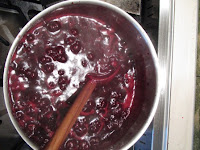 This entry covers three types of fruit that are at their peak at moment, apples, which we get from our youngest daughter Frances’ organic fruit farm, quinces and sloes, of which we got bumper crops from our garden this year.
This entry covers three types of fruit that are at their peak at moment, apples, which we get from our youngest daughter Frances’ organic fruit farm, quinces and sloes, of which we got bumper crops from our garden this year.Thanks to Caroline for supplying the recipes and the pictures.
Caroline’s Apple Bread
 As promised earlier, here’s the recipe for Caroline’s apple bread. Despite the main ingredient, apples, it goes well with sweet and savoury dishes. The apples used ideally should be slightly sour ones like boskop or bramleys.
As promised earlier, here’s the recipe for Caroline’s apple bread. Despite the main ingredient, apples, it goes well with sweet and savoury dishes. The apples used ideally should be slightly sour ones like boskop or bramleys.What you need
- 1kg wholemeal spelt flour
500 g tasty apples, perhaps slightly sour (see above), weighed after peeling and coring - 1 modest tablespoon salt
- 21 g yeast
- half teaspoon sugar
What you do
Cook apples until soft. Set aside until warm.Mix yeast and half teacup warm water plus sugar.
When frothy add flour, salt and warm apples.

Mix and knead. If necessary add warm water. It will be sticky.
Let it rise, covered with tea towel, in warm place until doubled in bulk.
Knead again

Divide between two small or out all in one larger bread tin.
Preheat the oven to 175° (fan oven), more if conventional
Cover the bread tins, leave in warm place until doubled in bulk.
Bake for 45 – 60 minutes, depending on size of tin and type of oven.
Caroline’s Quince Marmalade
The lovely flavour of a quince jelly or jam without the hard slog of cutting, peeling and coring.
What you need
- Quinces
- sugar (the amount depends on the cooking liquid; see below)
- optionally (I’m not sure Caroline would approve): a bit of quince shnapps to add to the flavour…

What you do
Wash the quinces and rub off the fluff.
Half to three quarter fill a very large pan with the whole quinces.
Cover them with water, bring to the boil and simmer until the skins start to come away.
Prepare glass jars. They should be clean and dry.
With a slotted spoon remove the hot quinces and place them in a bowl. Important: Keep the quince water!
Put skins and core back into water.
Simmer the (uncovered) quince water, the skins and cores until quantity of liquid has reduced by at least one third.
Chop remaining quince flesh into very small pieces.
Strain the quince water liquid through muslin, then dispose of the cores and the skin.
Measure the liquid before pouring it into a fresh, large saucepan.
Boil until the marmalade ready to set.
Remarks
Quince Marmalade is one of my all-time favourite fruit preserves. I always loved quince jelly and my Mum also made something she called “Chrusi”, which was orginally intended to make use of the pulp left over after the jelly liquid had been squeezed out. However, being such a stickler for culinary perfection, she used the entire fruit instead of the pulp, which made this much richer and tastier, jam, really.
The drawback in either case is that cutting the quince up for jelly or jam is a really tough job. Caroline’s approach is much less arduous and combines the rich sweetness of the jam with the delicate flavour and texture of the jelly; the result comes up in a beautiful orangey colour that I’m told is called “cornelian”. And as you use the same approach as you would for orange marmalade, i.e. cooking the fruit whole first, it makes more sense to call this marmalade rather than jam.
Caroline’s Sloe Jelly
What you need
Sloes (small plum type fruit that grow wild)
Sugar (the amount depends on the cooking liquid; see below)
optionally (I’m not sure Caroline would approve): a little sloe gin (recipe to follow soonest) to add to the flavour…
What you do
Put the sloes in a pan and barely cover with water.
Bring to the boil and cook, stirring the fruit from time to time, until there is a fair amount of liquid.
Strain the liquid from the fruit pulp, using a muslin bag.
Measure the fruit juice; as sloes are very tart, use somewhat more sugar than you would normally (at least 1.5 kg sugar to 1 litre of liquid).
Allow to simmer until the jelly is ready to set (see remarks below)
Fill into sterilized jars and seal tightly.
Remarks
A tricky thing for novices is to get the degree of boiling right, the moment when the jam, jelly or marmalade sets. To check this, place small plates in the fridge, take one out, place teaspoon of boiling jam on it. Leave it to cool for a minute. push jam gently with your finger. If it wrinkles, it is ready to put into prepared jars and fix tops on tightly.















No comments:
Post a Comment